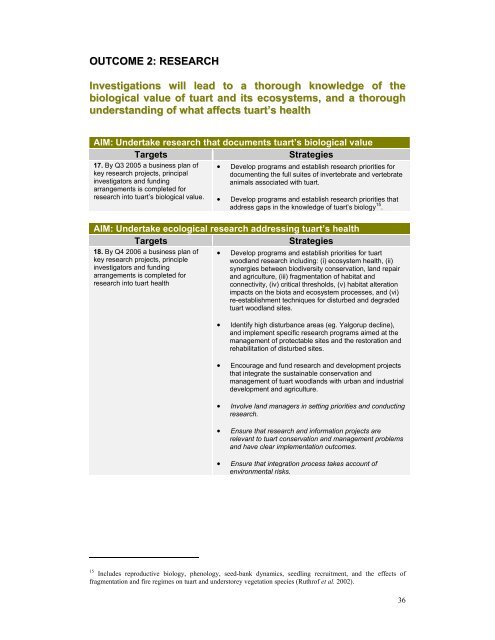DRAFT Tuart Conservation and Management Strategy
DRAFT Tuart Conservation and Management Strategy
DRAFT Tuart Conservation and Management Strategy
You also want an ePaper? Increase the reach of your titles
YUMPU automatically turns print PDFs into web optimized ePapers that Google loves.
OUTCOME 2: RESEARCH<br />
Investigations will lead to a thorough knowledge of the<br />
biological value of tuart <strong>and</strong> its ecosystems, <strong>and</strong> a thorough<br />
underst<strong>and</strong>ing of what affects tuart’s health<br />
AIM: Undertake research that documents tuart’s biological value<br />
Targets<br />
Strategies<br />
17. By Q3 2005 a business plan of<br />
key research projects, principal<br />
investigators <strong>and</strong> funding<br />
arrangements is completed for<br />
research into tuart’s biological value.<br />
• Develop programs <strong>and</strong> establish research priorities for<br />
documenting the full suites of invertebrate <strong>and</strong> vertebrate<br />
animals associated with tuart.<br />
• Develop programs <strong>and</strong> establish research priorities that<br />
address gaps in the knowledge of tuart’s biology 15 .<br />
AIM: Undertake ecological research addressing tuart’s health<br />
Targets<br />
Strategies<br />
18. By Q4 2006 a business plan of<br />
key research projects, principle<br />
investigators <strong>and</strong> funding<br />
arrangements is completed for<br />
research into tuart health<br />
• Develop programs <strong>and</strong> establish priorities for tuart<br />
woodl<strong>and</strong> research including: (i) ecosystem health, (ii)<br />
synergies between biodiversity conservation, l<strong>and</strong> repair<br />
<strong>and</strong> agriculture, (iii) fragmentation of habitat <strong>and</strong><br />
connectivity, (iv) critical thresholds, (v) habitat alteration<br />
impacts on the biota <strong>and</strong> ecosystem processes, <strong>and</strong> (vi)<br />
re-establishment techniques for disturbed <strong>and</strong> degraded<br />
tuart woodl<strong>and</strong> sites.<br />
• Identify high disturbance areas (eg. Yalgorup decline),<br />
<strong>and</strong> implement specific research programs aimed at the<br />
management of protectable sites <strong>and</strong> the restoration <strong>and</strong><br />
rehabilitation of disturbed sites.<br />
• Encourage <strong>and</strong> fund research <strong>and</strong> development projects<br />
that integrate the sustainable conservation <strong>and</strong><br />
management of tuart woodl<strong>and</strong>s with urban <strong>and</strong> industrial<br />
development <strong>and</strong> agriculture.<br />
• Involve l<strong>and</strong> managers in setting priorities <strong>and</strong> conducting<br />
research.<br />
• Ensure that research <strong>and</strong> information projects are<br />
relevant to tuart conservation <strong>and</strong> management problems<br />
<strong>and</strong> have clear implementation outcomes.<br />
• Ensure that integration process takes account of<br />
environmental risks.<br />
15 Includes reproductive biology, phenology, seed-bank dynamics, seedling recruitment, <strong>and</strong> the effects of<br />
fragmentation <strong>and</strong> fire regimes on tuart <strong>and</strong> understorey vegetation species (Ruthrof et al. 2002).<br />
36

















